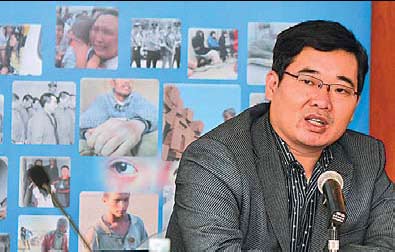 |
|
Chen Shiqu, director of the Ministry of Public Security's human trafficking task force, says the DNA database has helped many parents find their children. Zhu Xingxin / China Daily |
|
Thousands of families reunited by DNA tracking Thousands of children have been reunited with their parents thanks to a groundbreaking national DNA database, a leading figure in the fight against trafficking said. More than 2,300 youngsters, who were abducted, sold or reported missing, have been able to track their blood relatives, Chen Shiqu, director of the Ministry of Public Security's human trafficking task force, said in an interview. When police rescue abducted children or find vagrant youths, they immediately take blood samples for DNA sampling, he said. The exact number of entries in the database is unknown, but since its launch in April 2009 it has matched 2,348 children with their biological parents. Last year, it helped reunite 521 families. "It is especially efficient in helping parents and children who have been separated for years to find each other," he said. The system quickly compares DNA samples from both parents and children and can be accessed by police nationally. "Years of separation can change many things, especially a child's physical appearance," he said. The DNA database allows for an almost immediate identification. In November 2011, Gan Liang, who was abducted when he was 3 from Guizhou province in 1988, was reunited with his mother after 25 years, Guizhou Metropolitan Daily reported. The mother submitted a blood sample in 2010 through Baby Back Home, an NGO devoted to helping parents find lost children. Her son did the same in September 2011 at a police station in Shandong province. Zhang Baoyan, founder of Baby Back Home, said the database is "the most effective way" to reunite families. The website receives an average of 50 inquiries daily from both parents and people who think they may have been abducted. The NGO takes the blood samples and hands them to the ministry for DNA testing. "But there are still some parents of missing children who have no idea about the DNA database," she said. Chen said his department is drafting an action plan on human trafficking that will be issued this month. Police will target villages in Yunnan, Sichuan and Guizhou provinces, as well as the Guangxi Zhuang autonomous region, and take DNA samples from vagrant children and children they suspect may have been abducted. No matter what advanced technology police use, the key lies in tackling child abduction, Chen said. Those found guilty of the heinous crime should face more severe punishment, he said. In impoverished areas, such as Yunnan and Sichuan, villagers have sold their children and in relatively well-off provinces, such as Fujian, Guangdong and Shandong, childless couples have bought abducted children. These couples strongly believe in the importance of "carrying on the family line", and that it is important to have sons to support them in old age. Under the Criminal Procedure Law, buyers of trafficked children will only be held criminally responsible if they defied rescue efforts or physically abused the children. Chen said lawmakers are mulling revising the law. "Efforts should also be made to send signals to buyers that, no matter how many years they have kept the child, they are not the parents and will face severe punishment," he said. From January to October 2012, police handled 1,868 cases of child trafficking and 4,760 cases of human trafficking. About 1,240 trafficking gangs were smashed and 17,871 suspects detained, while police rescued 14,971 trafficked children and 9,156 abducted women.
|
——2009年,中国警方建立世界第一个DNA打拐信息库,目前,通过血型比对,已为2348名多年前失踪被拐儿童成功找到其亲生父母。 近日,公安部刑侦局打拐办主任陈士渠在接受中国日报独家专访时表示,自2009年中国警方建立世界第一个DNA打拐信息库以来,充分运用DNA高科技手段,使国内更多多年前被拐儿童顺利找到了其亲生父母。 陈说,自2009年以来,警方持续组织开展来历不明儿童集中摸排行动,各地对未办理户籍登记的,非亲属关系申报办理户口的,街头流浪、乞讨、卖艺、被强迫违法犯罪的,民政部门福利、救助机构收助的等13类儿童进行了摸排和采血检验,录入全国打拐DNA信息库比对。目前,全国打拐DNA 信息库已为2,348 名多年前失踪被拐儿童找到其亲生父母,仅2012年,通过DNA比对,使521名多年前失踪、被拐儿童成功与其父母团聚。 “运用全国打拐DNA信息库比对是使多年前被拐儿童成功找到其亲生父母的捷径,”他说。 “特别是对于一些拐卖儿童的积案,经过多年后,被拐孩子的体貌特征已经发生明显变化,警方很难用传统的手段进行侦查和破案。这时,打拐DNA信息库可以准确、快速的认定被拐儿童的身份,并通过比对成功找到其亲生父母。” 陈没有具体透露目前该DNA信息库所储存的相关信息总量,但说道,警方在工作中及时发现并采集来历不明、疑似被拐儿童,失踪被拐儿童父母的血样,并检测录入该DNA信息库。 陈士渠说,当前,我国经济社会发展不平衡、社会管理机制有待进一步完善,加之非法暴利的驱动和买方市场需求旺盛,部分地区拐卖犯罪依然突出,反拐工作任重道远。 他说,一些地区深受“传宗接代”,“养儿防老”和“多子多福”等传统落后观念影响,正常收养渠道手续繁琐,造成非法收养需求旺盛。 陈士渠说,新的《中国反对拐卖人口行动计划(2013-2020)》有望近期颁布实施,该计划在拐卖人口犯罪的预防、打击、救助、康复、国际合作等方面做了进一步细化,明确了相关政府职能部门的责任。 目前,公安部门正在会同全国人大法工委、最高法、最高检等部门研究修改完善刑事法律规定,加大对收买被拐卖妇女、儿童犯罪的惩治力度,他说。 目前,根据我国刑法的相关规定,如果相关买主没有阻碍警方解救和没有虐待被拐儿童,司法机关可以不追求其刑事责任。 陈士渠表示,接下来,警方将继续深化打拐专项行动,不断提升打击力度。督促各地公安机关继续严格落实“一长三包责任制“和“儿童失踪快速查找机制”,加强区域刑侦协作,完善打击拐卖犯罪合作机制,快侦快破现行案件,努力侦破历年积案。对工作中发现的拐卖犯罪线索一查到底,彻底摧毁犯罪网络,有效遏制拐卖犯罪案件的发生。 其次,警方将继续开展全国来历不明儿童集中摸排行动。督促各地公安机关组织民警走村入户,逐户逐人开展摸排工作,主动加强与民政、计生、教育、卫生、妇联等相关部门的沟通合作,及时发现来历不明儿童、疑似被拐儿童,并采血检验入库。 同时,要进一步规范涉拐DNA信息的采集、受理、检验工作,确保入库DNA信息的准确性和及时性,充分发挥全国打拐DNA信息库的效能,他说。 最后,警方将多措并举,加大对重点地区和买方市场的综合整治力度。会同民政部门、妇联等部门规范婚姻登记工作、畅通收养渠道,健全流浪未成年人的救助保护机制,提高部门间的信息互通和联动协助水平。 (中文部分为编译) (来源:China Daily 编辑:Julie)
|
|
|